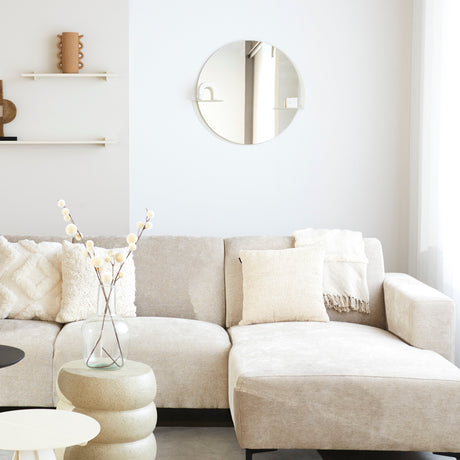Travertine is a great solution for lovers of marble, but prefer to choose a material that is affordable and indestructible. Travertine is a limestone that has been used in construction and decoration for centuries. From the Roman baths to contemporary design interiors: travertine remains fascinating with its subtle color variations and natural pores. In this blog, we zoom in on travertine as a material for furniture, and provide inspiration and tips to bring this beautiful natural product into your home.
Dimehouse naturally has many travertine products, and therefore we give you more information about the material travertine in this blog.
What is travertine?
Travertine is formed by the deposition of calcium carbonate in hot springs and caves.
- Color and structure: varying from cream and sand tones to soft brown shades, with characteristic cavities and veins. It resembles marble a lot.
- Hardness and durability: relatively sturdy, but slightly softer than granite; suitable for furniture production. Damage is hardly to never occur with travertine.
- Unique appearance: each slab is unique due to the natural pores and veins.
Why choose travertine for furniture?
- Aesthetics: the warm, neutral colors fit seamlessly into modern and classic interiors.
- Authenticity: the natural irregularities give a handcrafted appearance.
- Warmth: travertine feels more pleasant than cooler types of granite.
- Versatility: from living room to bathroom furniture, travertine instantly adds value and character.
- Luxury: travertine simply exudes luxury!
Popular furniture applications
- Coffee tables
Thanks to the sturdy slab and the beautiful contrast with a metal base, travertine coffee tables are a real eye-catcher. Nothing is as trendy as travertine coffee tables right now. - Dining tables
A solid travertine tabletop on a sleek frame combines robustness with elegance. - Side tables
Small, round or pentagonal designs highlight the marble-like veining beautifully. - TV furniture and sideboards
A travertine slab as a tabletop adds a timeless touch to lowboards and cabinets.
Design and styling tips
Combine travertine with steel, wood, or velvet for an exciting contrast. Especially contrasting colors, such as dark brown, pair wonderfully with the light travertine. Let the warm sandy tones return in cushions, throws, or decorative objects for a cohesive look in your living room.
Maintenance and care
- Regularly wipe with a dry or slightly damp cloth.
- Use a pH-neutral cleaner; no aggressive acids or abrasives.
- Scratch prevention: use placemats or coasters to limit contact with metal or sharp objects.
Conclusion
With travertine, you bring a piece of nature into your home that is timeless, atmospheric, and versatile. Whether you choose a subtle side table or a robust dining table: travertine instantly adds more character and luxury to any space. Through smart combinations with other materials and proper maintenance, you can enjoy the warm charm of this unique natural stone for years to come.
Let yourself be inspired by the possibilities and discover how travertine can transform your interior!






















